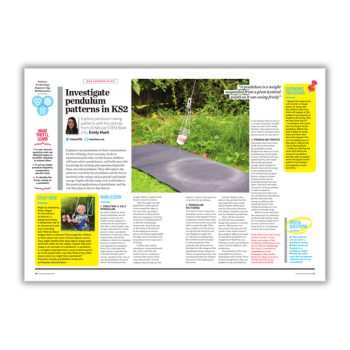PDF lesson plan of salt pendulum experiment for KS2.
KS2
Years 4-6
Engineers use pendulums in their constructions for lots of things, from everyday clocks to amusement park rides. In this gravity KS2 lesson, children will learn what a pendulum is, and build upon this knowledge by creating and experimenting with their own salt pendulum.
They will explore the patterns created by the pendulum and the forces involved in the swing, such as gravity and kinetic energy.
Pupils will also make real-world links to the practical applications of pendulums, and the role they play in day-to-day objects.
Gravity KS2 lesson
What they’ll learn:
- Ask relevant questions and use different types of scientific enquiries to answer them
- Set up simple practical enquiries, comparative, and fair tests
- Identify the forces acting on a pendulum
Starter activity
Begin by displaying three images for children to discuss:
- playground swing
- swing boat ride at an amusement park
- wrecking ball
What do these images have in common? Encourage the children to think about how each of these objects moves. They might identify that each object swings back and forth under its own weight. Explain that each image is an example of a pendulum.
A pendulum is a weight suspended from a pivot (central point) so it can swing freely. Can they think of any other places where we might find a pendulum?
Emily Hunt is an experienced primary teacher, senior leader and author of the 15-Minute STEM book series (Crown House Publishing). Emily also blogs and shares STEM activities on her website How To STEM.














